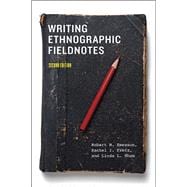
Note: Supplemental materials are not guaranteed with Rental or Used book purchases.
Purchase Benefits
What is included with this book?
| Preface to the Second Edition | p. ix |
| Preface to the First Edition | p. xiii |
| Fieldnotes in Ethnographic Research | p. 1 |
| Ethnographic Participation | p. 2 |
| The Complexities of Description | p. 5 |
| Inscribing Experienced/Observed Realities | p. 12 |
| Implications for Writing Fieldnotes | p. 15 |
| Reflections: Writing Fieldnotes and Ethnographic Practice | p. 18 |
| In the Field: Participating, Observing, and Jotting Notes | p. 21 |
| Participating in Order to Write | p. 24 |
| What Are Jottings? | p. 29 |
| Making Jottings: How, Where, and When | p. 34 |
| Reflections: Writing and Ethnographic Marginality | p. 41 |
| Writing Fieldnotes I: At the Desk, Creating Scenes on a Page | p. 45 |
| Moving from Field to Desk | p. 48 |
| Recalling in Order to Write | p. 51 |
| Writing Detailed Notes: Depiction of Scenes | p. 57 |
| Narrating a Day's Entry: Organizational Strategies | p. 74 |
| In-Process Analytic Writing: Asides and Commentaries | p. 79 |
| Reflections: "Writing" and "Reading" Modes | p. 85 |
| Writing Field notes II: Multiple Purposes and Stylistic Options | p. 89 |
| Stance and Audience in Writing Fieldnotes | p. 90 |
| Narrating Choices about Perspective | p. 93 |
| Fieldnote Tales: Writing Extended Narrative Segments | p. 109 |
| Analytic Writing: In-Process Memos | p. 123 |
| Reflections: Fieldnotes as Products ofWriting Choices | p. 126 |
| Pursuing Members' Meanings | p. 129 |
| Imposing Exogenous Meanings | p. 131 |
| Representing Members' Meanings | p. 134 |
| Members' Categories in Use: Processes and Problems | p. 151 |
| Race, Gender, Class, and Members' Meanings | p. 158 |
| Local Events and Social Forces | p. 166 |
| Reflections: Using Fieldnotes to Discover/Create Members' Meanings | p. 167 |
| Processing Fieldnotes: Coding and Memoing | p. 171 |
| Reading Fieldnotes as a Data Set | p. 173 |
| Open Coding | p. 175 |
| Writing Code Memos | p. 185 |
| Selecting Themes | p. 188 |
| Coding | p. 191 |
| Integrative Memos | p. 193 |
| Reflections: Creating Theory from Fieldnotes | p. 197 |
| Writing an Ethnography | p. 201 |
| Developing a Thematic Narrative | p. 201 |
| Transposing Fieldnotes into Ethnographic Text | p. 206 |
| Producing a Completed Ethnographic Document | p. 229 |
| Reflections: Between Members and Readers | p. 241 |
| Conclusion | p. 249 |
| Notes | p. 249 |
| References | p. 269 |
| Index | p. 283 |
| Table of Contents provided by Ingram. All Rights Reserved. |
The New copy of this book will include any supplemental materials advertised. Please check the title of the book to determine if it should include any access cards, study guides, lab manuals, CDs, etc.
The Used, Rental and eBook copies of this book are not guaranteed to include any supplemental materials. Typically, only the book itself is included. This is true even if the title states it includes any access cards, study guides, lab manuals, CDs, etc.